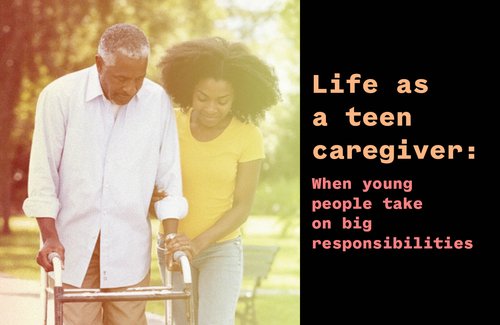
Many teens provide the important, and often unpaid work, of caregiving to others– including their parents, older family members and younger siblings.
Their extra responsibilities often impact their lives significantly– with research showing young caregivers spend less time on school, work, and leisure activities, compared to their peers.
For this project, talk to a teen who is a caregiver or tell your own story.
Here are some example questions for student caregivers:
This prompt is part of WELL BEINGS Caregiving, a documentary and community engagement initiative.
Watch SRL’s LEVEL-UP TUTORIAL SERIES before you begin filming
Tell your own story: Use SRL’s video diary tutorial to tell your own story and explain what kind of caregiving do and how you feel about it. Review the example questions for inspiration on what to talk about.
Tell a story about someone else: Interview a teen caregiver about their day-to-day life. Ask them to describe their days, how they feel and what they wish others knew. Review the example questions in this assignment, and ask good follow up questions.
For student stories to be considered for publication on national and local platforms, students must pitch a story idea, and if accepted, collaborate with SRL staff on production and edits. This will include a process of receiving feedback from SRL staff and making multiple edits and revisions, which may take several weeks/months, depending on the story. Learn more about pitching your story idea here.
Belief that someone or something is reliable, good, honest, effective, etc.
A subject or problem that people are thinking and talking about
A group of people who live in the same area (such as a city, town, or neighborhood). It can also be a group of people who have the same interests, religion, race, etc.
A simplified and standardized conception or image invested with special meaning and held in common by members of a group; a set form or convention
The condition of having or being composed of differing elements. Especially in the context of the inclusion of people of different races, cultures, etc. in a group or organization
The act or practice of including and accommodating people who have historically been excluded (as because of their race, gender, sexuality, or ability)
People are interested in other people. Everyone has something to celebrate and something to complain about. We like unusual stories of people who accomplish amazing feats or handle a life crisis because we can identify with them.
A conversation between two or more people where the purpose is to gather information and facts. The interviewer asks questions and the interviewee provides information based on their knowledge about a specific topic or issue.
An account of past or current events. In journalism, stories are presented with a combination of people, facts, and typically includes a beginning, middle and end.
A person or other physical being in a narrative. Stories are made up of different characters who provide information and help shape the narrative with their knowledge, experience and perspective.
The term “empathy” is used to describe a wide range of experiences. A generally definition is the ability to sense other people’s emotions, coupled with the ability to imagine what someone else might be thinking or feeling. In media-making, creators can have empathy for their subjects and the audience can empathize with the characters.
Active Prompts
Beginner
Intermediate
Advanced
About 4-6 weeks